Steam generators in thermal (steam-cycle) power plants require a constant influx of cool water to maximize the transfer of thermal energy. How this water is cooled again in the condensor after much of the steam’s thermal energy has been spent in the steam turbines or heat exchangers is a very important consideration in the design and construction of these plants. The most obvious and straightforward system is direct “once-through” cooling, where the water is drawn straight from a nearby river or other body of water and released after passing through the condenser. This type of system is by far the cheapest, but is also impacted by both the seasons and environmental considerations.
Where cool surface water is less abundantly available, evaporative cooling in a recirculating system such as with spray ponds and cooling towers is a good alternative. Although slightly more costly, a big benefit of these is that they require far less water and have much more control over the intake water temperature, which can raise plant efficiency. Finally, dry cooling is essentially a closed-loop system, which is exceedingly useful in areas where water is scarce. This latter type of cooling is what allows thermal plants to operate even in desert regions.
As the global climate changes – with more extreme weather events – picking the right cooling solution is more important than ever, and has us looking at retrofitting existing thermal plants with more efficient solutions. If you were ever curious how power plants keep the cool side cool, read on!
Chilling Plants
Getting rid of surplus heat is a common aspect of many systems, from vehicles and building HVAC all the way to gigawatt-level thermal plants, yet the basic principles and technologies remain the same. Although office buildings tend to not use direct intake cooling, they do often have HVAC towers on the roof which use evaporative cooling in a way that is essentially a scaled-down version of a thermal plant’s evaporative cooling tower, or alternatively a closed-loop dry cooling system.
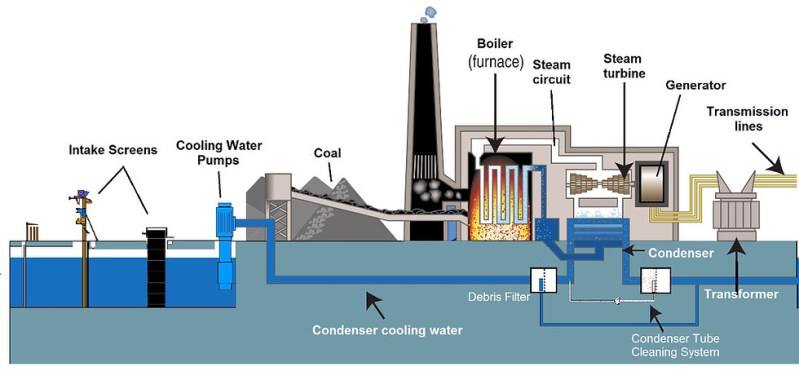
Within the different categories of thermal plants (being primarily coal, gas and nuclear), there are a lot of similarities between these different plant types, though also noticeable differences. Perhaps most important of all is that coal plants get rid of part (about 15%) of their surplus thermal energy in their exhaust (flue) gas, and gas plants primarily using the exhaust gases, while nuclear plants have to fully use their condensers for this.
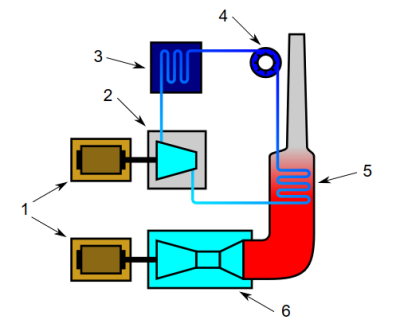
Each plant type has a few different possible configurations for their steam and coolant loops, with the common configuration for coal plants being that of the boiler which used for the combustion of fuel and which also contains the steam circuit loop that drives the steam turbines. Gas plants are the odd duck here, as their use of a gas rather than steam turbine in their first stage means that at least Open Circuit Gas Turbines (OCGTs) without a second stage do not have a steam circuit and thus condenser.
The OCGT configuration has a fairly low efficiency of ~30%, however, which is why the Combined Cycle Gas Turbine (CCGT) uses a second stage with a heat exchanger in the hot exhaust that creates a steam circuit with accompanying steam generator that boost overall efficiency to 50-60%. This means that CCGT plants also require a cooling solution akin to other thermal plants, although the fairly high thermal efficiency makes these cooling requirements relatively minor.
Since all of these thermal plants that have a steam cycle run a non-ideal Rankine cycle, their thermal efficiency is determined largely by the difference between the hot and cold sides. The effect of this can be observed by the thermal efficiency of a number of plants around the world, with the optimal condition being located near a body of cold water – such as a deep lake – with the steam temperature in the steam circuit being the other factor. This is why e.g. the molten salt fast neutron reactor at Beloyarsk 3 (BN-600 FNR) hits a thermal efficiency of 41.5%, whereas light water reactors (LWRs) more commonly reach an efficiency of between 30-38%. This places high-temperature nuclear reactors like the BN-series in the same ballpark as today’s supercritical coal-fired plants (around 40% thermal efficiency).
Although in some situations part of the surplus thermal energy can be used via an additional heat exchanger for purposes such as district heating, the coolant water will always pass through the condenser for cooling.
Environmental Considerations
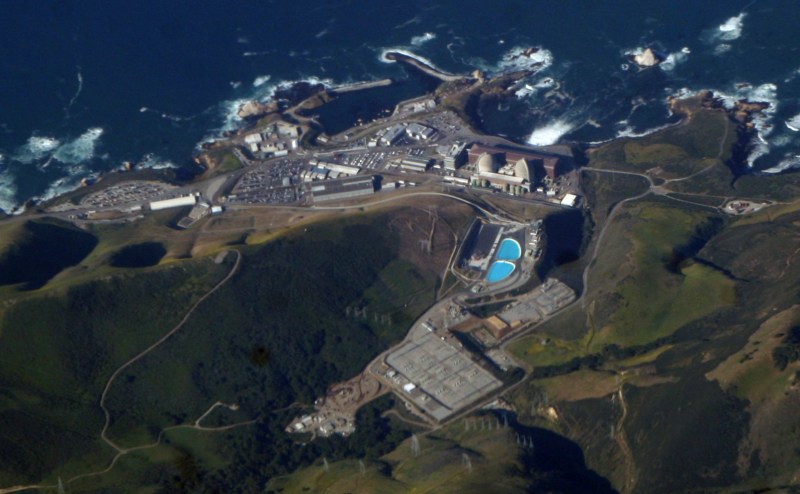
As with any process that interacts with the environment, the intake and potential release of cooling water will affect the local environment and/or ecology in some manner. The obvious examples here are the intake of marine life such as fish and smaller creatures as well as eggs, and the release of warmer water into the marine environment in the case of direct-through cooling. These tend to be the highly contentious topics that are often leveraged against thermal plants, with a particular focus on nuclear plants by anti-nuclear power groups, despite nuclear plants using only slightly more cooling water than coal plants.
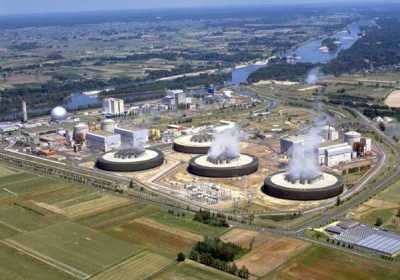
Fact of the matter is that there are strict regulations for water release temperatures from thermal plants, with each nation and region having its own allowed increase in river water temperature, and thermal plants being throttled back if water intake temperatures exceed a certain threshold. Meanwhile, the removal of debris, plant matter and other particulates from intake water is a major concern, whether for hydropower dam turbines or for thermal plants. The goal is to prevent anything but water from entering through the debris filters, with biocides especially crucial in recirculating cooling systems to prevent the build-up of biofilms and fouling.
An effect of these debris filters and screens is that marine life can impinge on them, which tends to be fatal. Yet this is an issue that is common to all once-through cooling solutions, as well as hydropower dams. Environmental studies here such as for Diablo Canyon in California have indicated that while this is something that definitely happens, the total impact on the environment is negligible. Building cooling towers and recirculating water to massively reduce the required intake of cooling water is preferred these days, especially for new inland plants, where the use of cooling towers is increasingly more common.
Balancing The Budget

When a thermal plant is located next to an ocean or large lake, it is hard to argue about a water budget being an issue. Where things get a lot less roomy in said budget is when the plant is located next to a river, since the water level in rivers tends to fluctuate, along with the water’s temperature. This is a factor which makes once-through cooling somewhat problematic, especially in the case of a hot summer with little in terms of rain.
A less obvious benefit of foregoing once-through cooling in favor of recirculating cooling is that of safety. This was illustrated recently during the Russo-Ukrainian war, when Russian forces blew up the Kakhovka dam that contained the reservoir which also provided cooling water to the Zaporizhzhia nuclear power plant (ZNPP). Because ZNNP was designed with a recirculating system containing a spray pond (a cheaper predecessor to cooling towers), its cooling pond contains a significant body of water that evaporates very slowly when the plant’s six reactors are in use. If once-through cooling had been used, the vanishing of the reservoir would have required immediate emergency procedures. Instead, the cooling pond can be refilled via alternate methods such as local wells, turning a would-be-emergency into an annoying logistical complication.
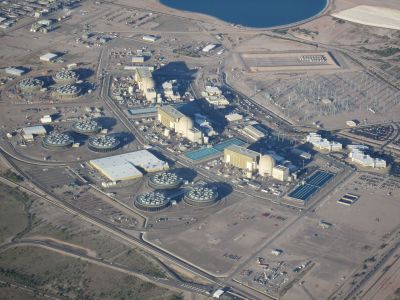
On the opposite end of the water budget spectrum, far away from the plentiful water off California’s coast, we find the arid state of Arizona, which gets over a third of its electrical power from the Palo Verde Generating Station. This thermal plant’s condenser is cooled using treated sewage from nearby cities, and demonstrates this way just how efficient even evaporative cooling towers can be.
If the water budget is even more constraint, the alternative to wet cooling towers is dry cooling, which uses the equivalent of radiators and forced airflow over its fins. Since this is significantly less efficient than wet (evaporative) cooling, it is not a method that is often considered for commercial thermal power plants. Even so, it has been employed in the past on prototype plants, such as the German THTR-300 nuclear reactor, and some coal plants use air-cooling, as in some of Eskom’s coal plants in South Africa, including some units dating back to the 90s.
Interestingly, there’s a growing interest in dry cooling retrofits for existing (fossil fuel-fired) plants, such as covered in a recent paper by Haibo Zhai et al. in Applied Energy. Although the local environment and climate has to be considered with such retrofits and new builds, the general trend would appear to be one away from once-through cooling, and towards the use of cooling methods that both use less water, and are less dependent on the whims of the environment, let alone human-made disasters.

















Where I live in West Virginia (Yes, the state in the United States that looks like it’s “giving the finger” to the everyone on the map…which I despise that reference…but yet I digress), There is the John Amos Power Plant about 10 miles from my house. Those evaporating towers of the coal powered plant are quite interesting. My youngest daughter called them “Cloud Generators” when she was younger. Anyways…interesting tech on cooling. Here’s the link to the plant for those interested:
https://en.wikipedia.org/wiki/John_E._Amos_Power_Plant
73’s DE KC8KVA
Some. (many!) years ago I was working in the Middle East, for a power consultancy, but on the networks side. It became obvious quickly that cooling was an issue at the gas powered plants. Many were OCGT, and what CCGT existed used forced cooling. Not being a thermodynamics type I still knew that this was wasteful. I did wonder at the time if a second stage of cooling could be adopted (what we would now know as a heat pump) and the heat created then could be used to preheat the water returning to the boiler. I have mentioned this idea to a few people over the years, and have yet to receive a “that won’t work because …” but it is a simple idea, so I must have missed something.
With rankine, regenerative heat exchangers often do the preheating.
The energy needed to heat the water to just below boiling is comparatively small, so the gasses from the turbine can’t dump much of the remaining energy into the feed water after leaving the boiler. In other words, with the energy contained in the gas at boiling temperature in the boiler you could preheat much more feed water than is needed.
It is possible to build in an intermediate heat exchanger between a high pressure and a low pressure steam turbine to regain some more energy from the exhaust gasses and to avoid condensing conditions in the low pressure turbine. The added complexity might outweigh the benefits though.
>Since all of these thermal plants that have a steam cycle run a non-ideal Rankine cycle, their thermal efficiency is determined largely by the difference between the hot and cold sides.
This may be misleading. The ideal carnot cycle’s efficiency is determined by the difference in hot and cold temperature. These nonideal Rankine generators are all very similar in how they reach a good fraction of that limit, and so their main determining factor is what the carnot limit is for their operating temperatures. A car engine’s often uses a cycle whose determining factor in theory is the compression ratio. In practice they don’t achieve very close to it, but still.
I wish I had some CCGT generation around instead of coal; that’s nice efficiency from the hydrocarbon with the least possible carbon.
CCGT is good from an efficiency point of view, but not so good on flexibility. I expect more of a role for OCGT peakers in the future. The ability to scale up and down quickly is the key in an age where renewables will make up the bulk of our generation capacity.
CCGT as I understand it can start up ahead of time, run for a few hours, and stop again each day with no problems, ramping fast enough to handle the duck curve. Though compared to my local coal plant, even if they ran them constantly it’d be an improvement.
OCGT peakers, as I understand, can get you a boost in less than 10 minutes if you realize you need some extra, but aren’t as efficient so they try not to use them the rest of the time.
I think 10 minutes is a reasonable fastest time for current batteries to empty themself, though of course the inverter would need to be huge.
https://www.nrel.gov/docs/fy20osti/73856.pdf I read this after you pointed that out.
Umm… The Beloyarsk reactors are not molten salt reactors. They liquid metal fast breeder reactors (LMFBRS) using metalic sodium as a coolant.
And here I clicked on the article to find out which types of vegetation are considered “thermal”.
“when Russian forces blew up the Kakhovka dam that contained the reservoir which also provided cooling water to the Zaporizhzhia nuclear power plant”
This is far from certain, indeed the biggest effect was to flush out russian defensive positions on the east side of the river, and the timing coincided with the ukraine ‘counter-offensive’, so it’s entirely likely that ukraine were responsible for this.
There is much propaganda around the conflict, and both side’s statements should be taken with a grain of salt.
We tend to be fed Ukraine’s perspective, and sometimes the bias seeping through is obvious.
That all being said, I have no doubt that Putin is awful. Also, the conflict in Ukraine is a bad thing.
With the weapons available to Ukraine, a dam this big could not have been destroyed from the outside…Russia was in control of the Kakhovka dam, and explosives that could potentially be used for the destruction of the dam were spotted in the vicinity already in autumn last year.
So, while there may be no final proof it seems quite unlikely that Ukraine could even achieve the dam’s destruction without controlling it
Would be nice to see cooling systems like these diverted into municipal hot water systems. We waste so much energy trying to heat one area and cool another, with a little cooperation we could do much more with far less energy. They do a great job of this in Reykjavik.
We tend to keep power plants, hot industrial processes etc away from people because no-one wants to live next to them. Transporting hot water tens of miles without losing the heat is not so easy.
When losing heat is your goal, efficient heat transport is not that high on your agenda :-)
the cooling towers get heat at about 35°C, district heating taps the 130°C level, so replacing the towers with district heating takes a hefty bite in the electrical efficiency of the plant
Rochester, Minnesota’s Waste to Energy plant supplies waste heat to a nearby college complex, including an inflatable field house (during the winter). Other government buildings nearby may also benefit.
Waste heat from the Mayo Clinic’s (Rochester) power plant is piped to their downtown campus. I believe the City of Rochester’s power plant also supplies waste heat to downtown buildings.
(Population ~100,000)
There is no such thing as ‘waste heat’ in the arctic tundra.
NuScale’s new VOYGR plant up near Idaho National Laboratory will allegedly use dry cooling. I wonder if they’ll just be using a radiator with forced air or something more clever. Does anyone know how much of an efficiency difference there is between an evaporative system and a dry system?